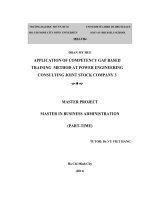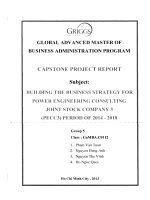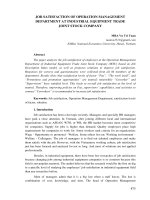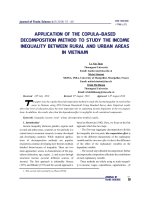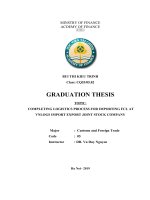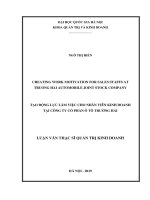Application of competency gap based training method at power engineering consulting joint stock company 3
Bạn đang xem bản rút gọn của tài liệu. Xem và tải ngay bản đầy đủ của tài liệu tại đây (690.56 KB, 98 trang )
TR
NG
IH CM
TP. HCM
UNIVERSITÉ LIBRE DE BRUXELLES
HO CHI MINH CITY OPEN UNIVERSITY
SOLVAY BRUSSELS SCHOOL
MBAVB4
DOAN MY HUE
APPLICATION OF COMPETENCY GAP BASED
TRAINING METHOD AT POWER ENGINEERING
CONSULTING JOINT STOCK COMPANY 3
}ı|
MASTER PROJECT
MASTER IN BUSINESS ADMINISTRATION
(PART-TIME)
TUTOR: Dr.VU VIET HANG
Ho Chi Minh City
(2011)
DECLARATION AND CONFIDENTIALITY
I confirm that this thesis is a presentation of my original research work which I have
studied, researched. Wherever contributions of others are involved, every effort is
made to indicate this clearly, with due reference to the literature, and
acknowledgement of collaborative research and discussions.
The work is done for the study purpose, it contains some confidential
information of the PECC3, therefore the copying or using of this paper for any other
purpose must be subject to the written acceptance of the author.
Candidate’s name and signature
Doan My Hue
ACKNOWLEDGEMENT
I would like to express my heartfelt gratitude and deepest appreciation to my research
Supervisor, Dr. Vu Viet Hang for her precious guidance, share experience, ceaseless
encouragement and highly valuable suggestions throughout the course of my
research. I would like to thank my colleagues from PECC3, who have helped me
during the collection of data as well as support me doing research. Special thanks
again to the staff members have spent their time to fill in the survey of employees in
company to obtain data for analysis and evaluation.
My special gratitude is extended to all instructors and staff at Faculty of
Business Administration and Postgraduate Faculty of Open University (OU) for their
support and the valuable knowledge during my study in OU.
I also would like to thank the Examination committee for take time and giving
valuable comments to improve this study.
Last but not least, the deepest and most sincere gratitude goes to my
professors who helped me to get to the precious knowledge.
TABLE OF CONTENT
Page
ABBREVIATION ..................................................................................................................i
TABLE LIST......................................................................................................................... ii
CHART LIST....................................................................................................................... iii
INTRODUCTION.................................................................................................................1
Problem statement ...................................................................................................................1
Research objectives .................................................................................................................2
Data collection method............................................................................................................2
Scope and limitations...............................................................................................................2
Implications of research ..........................................................................................................3
Structure of the study...............................................................................................................3
CHAPTER 1: THEORETICAL BACKGROUND ........................................................4
1.1.
Training ..........................................................................................................4
1.2.
General about competency gaps based training.............................................6
1.2.1.
Concept of competency and competency gap................................................6
1.2.2.
Determination of Competency Gap ...............................................................7
1.3.
Model of American Society for training and the competency based model of
Boyatzis.......................................................................................................................9
CHAPTER 2: THE SITUATION OF TRAINING AT POWER ENGINEERING
CONSULTING JOINT STOCK COMPANY 3............................................................18
2.1.
Brief outline of Power Engineering Consulting Joint Stock Company 3 ....18
2.1.1.
History of establishment and development..................................................18
2.1.2.
Company organization structure ..................................................................19
2.1.3.
Business activities and situation ..................................................................22
2.1.4.
Human resource situation at PECC3............................................................23
2.2.
Training in PECC 3......................................................................................26
2.2.1.
Training process...........................................................................................26
2.2.2.
Training organization...................................................................................27
2.2.3.
Comments on training of PECC3 ................................................................29
CHAPTER 3: APPLICATION OF COMPTENCY GAP BASED TRAINING
METHOD AT PECC3........................................................................................................35
3.1.
The establishment of application competency gap based training system for
PECC3 36
3.1.1.
The approach................................................................................................37
3.1.2.
Definition of training needs .........................................................................40
3.1.3.
Definition the core values of company ........................................................40
3.1.4.
List of capabilities needed for different level ..............................................41
3.1.5.
Definition the required and actual importance, proficiency of the
competencies .............................................................................................................44
3.1.5.1. Definition capacity gap of management positions.......................................44
3.1.5.2. Indentify competency gaps of administration and management employees45
3.1.5.3. Indentify competency gaps of technical engineers ......................................45
3.1.5.4. Indentify competency gaps of technical workers.........................................45
3.2.
Support solutions..........................................................................................45
3.2.1.
Improving the recruitment process ..............................................................45
3.2.2.
Application of quantitive analysis to performance appraisal.......................45
3.2.3.
Training competency gap method for managers..........................................45
CONCLUSION....................................................................................................................45
REFERENCES.....................................................................................................................45
ANNEX..................................................................................................................................45
i
ABBREVIATION
EVN
: Vietnam Electricity Corporation
HR
: Human Resource
HRM
: Human Resource Management
GDP
: Gross Domestic Product
NPT
: National Power Transmission Corporation
PECC 3
: Power Engineering Consulting Joint Stock Company 3
VN
: Vietnam
HCMC
: Ho Chi Minh City
ii
TABLE LIST
Table 1.1
Actual proficient of competencies
14
Table 2.1.
Business results over last years of PECC 3
23
Table 2.2.
Labor structure according to professional of PECC3
24
Table 2.3.
Labor structure according to training level of
26
PECC3
Table 2.4.
Training organization in PECC 3
27
Table 2.5.
Training expensive
30
Table 2.6.
Opinion on training with job requirements
31
Table 2.7.
Opinion on content of training
31
Table 2.8.
Opinions on teaching method
32
Table 3.1.
Specialized trainings required for staff
36
Table 3.2.
List of capacity groups
42
Table 3.3.
Identification capacity groups of management
45
positions
Table 3.4.
Identification capacity groups of administration and
49
management employees
Table 3.5.
Identification capacity groups of technical engineers
53
Table 3.6.
Identification capacity groups of technical workers
57
Table 3.7.
Additional competencies needed
59
iii
CHART LIST
Chart 1.1.
Determination competency
11
Chart 2.1.
Organization chart of PECC3
21
Chart 2.2
Labor structure according to professional
24
Chart 2.3
Labor structure according training level
25
Chart 3.1.
Proposed recruitment process of PECC 3
61
Problem statement
1
INTRODUCTION
Problem statement
Any company only can be successes with long-term continuous improvement.
Current business environment is influenced by the trend of globalization, is changing
extremely rapidly in Vietnam. The organizations have recognized that they must
change their basic strategy and change their focus from increasing sales to value
added. Also from the quality and quantity from price competition the service to
competition. Thus organizations are under increasing pressure of how to improve the
quality for their limited resources to these resources more creativity and innovation, to
achieve the output value of organization. From the quality and quantity from price
competition the service to competition. Thus organizations are under increasing
pressure about how to improve the quality for their limited resources to these
resources more creativity and innovation, to achieve the output value of organization.
With such a pressure, the improvement of training and development resources become
a vital aspect of the development of the organization.
Currently, the investments from the strong economies in the world are coming
into Vietnam from developed countries in the region such as Japan, Korea, the
countries from Europe, America as Britain, France, United States, ... they bring the
new management style and focus on training and human resource development of
Vietnam, to meet increasing demands in the competitive business world.
PECC3 after 5 years switching to joint stock Company, it has always archived
the goals of business planning. These results, based on the company’s business plan,
are professional and creative breakthroughs to the staff of the company. To promote
and maximize the capacity and ability of all single people, the company has always
focused on the training and development policies of human resource development.
Scope and limitations
2
Based on the understanding the role of training policies and human resource
development, along with required training of human resources of production, the
theme: "Application of competency gap based training method in Power Engineering
Joint Stock Company 3” has been chosen.
Research objectives
The theme sets forth views in the application of the capacity gap based training
methods in the Power Engineering Consulting Joint Stock Company 3.
To achieve this purpose thesis has the following tasks:
-
Reviewing the theory of
the competency, competency gaps and
competency gaps based training
-
Identification the overall human resource management and training of
company
-
Application the competency gaps based training method to training in
PECC3
Data collection method
The data thesis collection methods for this thesis mainly are based on desk
review the data source of company, regulations, reports, plan, questionnaires related to
the thesis, group discussion, and interview to direct approach to training program
based on competency gap in PECC3, and then clarifies the perspectives and solutions
to use it most effectively.
Scope and limitations
The object of this research is the workforce of the Power Engineering
Consulting Joint Stock Company 3 and thesis limited in the core content of
3
competency gap based training to effectively develop the human resources at the
company.
Implications of research
Through the analysis and interpretation of the contents is determined, the thesis
can get the practical meanings as following:
Improve the competitive position of the company in the market through
capacity building through competency gaps based training method.
Developing a training policy in a manner that is new training method based on
competency gaps.
Providing a theoretical basis, the information and data necessary to the
scientific research, teaching, management and training methods used in the human
resource management of power industry in Vietnam
Structure of the study
Beside of introduction, conclusion, references and appendices, the thesis
includes three chapters:
Chapter I: Theoretical background
Chapter II: The situation of training at Power Engineering Consulting Joint
Stock Company 3
Chapter III: Application of competency gap based training method in Power
Engineering Joint Stock Company 3.
CHAPTER 1: THEORETICAL BACKGROUND
4
CHAPTER 1: THEORETICAL BACKGROUND
Human resource management today is much more integrated and
strategically involved. Attracting and retaining right employees is vital for the
sustainability of an organization. The importance of training and empowering the
workforce is, therefore, recognized by managers of each unit and functional areas of
an institution.
1.1. Training
Training is a learning system set up by the organization in order to improve
knowledge and skills of employees so that they can apply it to daily works helping
them to be successful in their job performance.
The training needs assessment is very important for the organization because
through this assessment we can find out whether the training is necessary or not and
whether trainees have basic skills to fully benefit from the training content or not.
Moreover, organizations have to make sure that they create a good
environment for learning. After the training, the organizations should do the training
follow up to ensure that the trainees put it into practices in their everyday works. What
is more, this will help evaluate the training outcome and objectives whether it is
achievable or not. The assessment helps determine for example what kind of trainings
that the organizations should provide to their staff and who should attend the training
courses. Furthermore, according to Noe, Hollenbeek, Gerhart, and Wright, the
organizations can also find out the specific areas to be focused on. The training
curriculum should be developed to meet the outcome that organization wants. It is also
very important because it links to the effectiveness of the trainings. After training,
trainers should develop a form for participants to evaluate both content and techniques
used in training in order to improve future trainings. The organization should make
CHAPTER 1: THEORETICAL BACKGROUND
5
itself become a learning organization so the staff is continuously willing to learn the
new work practices and apply what they have learnt to improve the quality of their
works.
To improve the quality and effectiveness of training and development
resources, access to power is very popular in worldwide.
Access capability was formed in the United States from the 1970s in movement
training of trainers and human resource development by qualified to perform specific
tasks. This approach has the capacity to develop a new step in the years 1990s with
many national organizations in American, Australia, New Zealand, and Wales.
Access competencies in training and development resources have the following
advantages:
- Access to power is based on education method which learners are center of
training. Based on the model competency gap training, the study will complement the
shortage of individuals to perform their specific tasks.
- Focused on output.
- Access to flexible capacities to achieve outcomes in ways consistent with its
own characteristics and circumstances of the individual.
- Access competencies can clearly define what needs to achieve and determine
the criteria to measure success.
With achievements of the objective point in the policy of training and human
resource development, competency-based model has been developed throughout the
world with national systems of vocational trainings in England and Wales, with
national qualification framework in New Zealand, the National Training Board in
Australia.
CHAPTER 1: THEORETICAL BACKGROUND
6
1.2. General about competency gaps based training
1.2.1. Concept of competency and competency gap
Recently “capacity” term used often in HRM (mostly translated into
“competency”). For example:
+ Competency based management
+ Competency based model
+ Competency based training and development
There are many definitions on competency, depends environment and goals to
use that capacity. But in general competency consist of the skills and knowledge
required by employees to effectively perform their jobs or specific tasks the company
assigns to them from time to time.
Competency gap is the different between current competency level (CCL) of
employees and required competency level (RCL). And according to Patricia K.
Zingheim, et al, competency gap is the difference between the existing abilities and
skills of employees and what are expected of them in achieving the objectives that the
company wants them achieve is the skill and knowledge gap.
The four general areas of competency are:
1. Meaning Competency: The person assessed must be able to define with the
purpose of the organization or community and act from the preferred future in
accordance with the values of the organization or community.
2. Relation Competency: The ability to create and nurture connections to the
stakeholders of the primary tasks must be shown.
3. Learning Competency: The person assessed must be able to create and look
for situations that make it possible to experiment with the set of solutions that make it
CHAPTER 1: THEORETICAL BACKGROUND
7
possible to complete the primary tasks and reflect on the experience.
4. Change Competency: The person assessed must be able to act in new ways
when it will promote the purpose of the organization or community and make the
preferred future come to life.
Here, the competency is capacity to complete the activities (assignment, jobs)
based on standards of that assignments; In other words, competency are capacities,
knowledge, attitude required to a person to implement a job with good results .
1.2.2. Determination of Competency Gap
Based on the Kenneth H. Pritchard, “Introduction to Competencies,” White
Paper, 1997, Society for Human Resource Management, determining the skills and
knowledge gaps of employees is a necessary part of company’s human resource plan.
In order to indentify the competency gap of any employee, it necessary to determine
the following:
- The types of competencies required performing the job
- The required competencies level required of the employee
- The competency standard for each of the position in the organization
-The majorities of competencies relate to functional and behavioral
competencies of employees and vary from the top level to the lowest. Core
competencies are common competencies for every position in the organization.
The required competency level is the standard of performance for each duty
based on industry standard. The "industry" refers to the type of industry in which the
company is carrying out its activities.
The standard can range from 3 as being satisfactory to 4 as having performed
beyond the expectation of the organization or 5 as having performed to industry
CHAPTER 1: THEORETICAL BACKGROUND
8
standard. An employee who has attained a rating of "5" is considered as an expert in
his or her field.
The main task here is that carefully examine anything lower than this.
The employee's competency is assessed at the end of a certain period of time,
usually one year and no shorter than nine months.
Normally the current competency level is based on ratings such as:
1 for beginner's level
2 for below standard
3 for satisfactory performance
4 for performance beyond expectation, and
5 for performance to industry standard
For example, if the RCL is 4 and the assessment by the supervisor indicates
that the employee's CCL is 3, the "competency gap" is "1" expressed as a percentage.
If the CCL is 4 and the RCL is 3, the employee had exceeded expectation.
Everyone needs to know and understand that there are limitations to capabilities of
technology.
Managers and supervisors must understand what to achieve their own ends or
to help people under their jurisdiction. This can include the case whereby the ability of
the employee is either indicated as adequate. It may also happen that the employee's
competence is stated as too low thus not reflecting the true current position.
The organization needs to ensure that every manager and supervisor is
equipped with the skills in determining the RCL and the CCL to ensure accuracy of
the competency gap of each of their subordinates.
The results of the competency assessment are not meant for determining salary
CHAPTER 1: THEORETICAL BACKGROUND
9
increase, however the information is useful (provided the assessment is done properly)
in determining whether the salary level of the employee is equitable, that is, it reflects
his skills and knowledge apart from how responsible the job is.
Further, it is not necessary to determine the skills and knowledge gap in respect
of every duty and responsibility. Select the critical ones that go towards the
achievement of employees' job objectives and company's overall strategic plan.
1.3.
Model of American Society for training and the competency based
model of Boyatzis
One of the most typical example and is considered the most successful model
of the American Society for Training and Development. In an effort to establish
standards for training and development - Models McLagan has been established and
used in universities as well as training in the U.S. as in many other countries around
the world. McLagan's model of practical human resource development has achieved a
number of objectives:
• Summary 11 the role of the professional development of human resources:
Administrative managers, evaluators, managers, financial and training materials
developers, business development consultant, trainer, marketing managers, the needs
analysis experts, the subject of organizational change persons, designers and programs
researchers.
• Define and define 25 major capabilities of human resources development and
is divided into four groups: technical capabilities, business, relationships between the
personals and intellectual thinking.
• Define requirements for each product quality of work output in human
resource development
In the capacity based model, the role of professionals and the capacities of key human
CHAPTER 1: THEORETICAL BACKGROUND
10
resource development are focused.
* The model is based on the capacity of Boyatzis
Boyatzis's model has a very extensive influence in studies of competency
management as well as practical training and management development.
Boyatzis and Whetten & Cameron (1995) suggested that development
programs training based on the model capacity to handle a systematic way following
three aspects:
- Determine the capacity
- Develop the capacity
- Assessment them objectively
So when organizing training courses in our administration should be based on the
capacity mentioned above, to determine the need for training capability is essential.
The model is based on the competency of Boyatzis to determine the capacity of
managers, is divided into five groups:
Management objectives and actions: the performance-oriented, proactive
action, use the concept for diagnosis and care about the effects
Leaders: confidence, presentation using verbal, logical thinking, the
generalization
Human Resource Management: use of social power, positive attention to
people, managing the group process, self-appreciation
Direct the activities of subordinate: Develop the subordinates and use unilateral
power, unrestrained
Pay attention to around people: autonomy and objectivity in thinking, ability to
adapt and endure, caring and friendly people.
CHAPTER 1: THEORETICAL BACKGROUND
11
Training competency gap training methods is based on this model.
* The main steps of a model of competence:
- Step 1: Define the vision, mission and strategic goals of the organization
- Step 2: Determine the processes, systems and internal procedures to achieve
the vision, mission and strategic objectives have been identified
- Step 3: Determine the capacities needed to achieve the mission and objectives
identified
- Step 4: Define gaps, competency gaps and form the development plan of the
individual and the organization
- Step 5: Integrate these plans into development plans human resources the
organization.
Training the competency gap
Training the competency gap identified capacities need to be trained as
followed chart:
Chart 1.1: Determination competencies
a. Definition the list of competencies
a1. Define policies and objectives of the organization
a2. Defining, grouping and selection competency
a3. Define all the capacities
a4. Define the importance
a5. Complete dictionary of capacities
CHAPTER 1: THEORETICAL BACKGROUND
12
b. Determination of rate competency (capability gap)
b1. Determination proficiency level of capacity required
b2. Determination proficiency level of the actual
b3. Determination the rate of capacity
c. Curriculum planning and development
a. Definition the list of competencies
a1. Definition policies and objectives of the organization
The process of training competencies gap is a complex process, difficult to
manage unless it is planned and implemented carefully. Participants and methods of
implementation must be determined before work is started.
First, organizations must set up the Council to research program and determine
responsibility for each member. Composition of the Council is very important,
including the prestigious representatives of the units in the organization (departments,
units). The policies and objectives of the organization will be established by this
Council.
a2. Definition, grouping and selection competency
Based on the policies and objectives of the organization identified above, the
Council will define and define the competencies required for the organization.
Council will then group the capabilities. Total group and the group's name will
depend on which model capacity based organizations to establish this training process.
CHAPTER 1: THEORETICAL BACKGROUND
13
a3. Definition all the capacities
The Council will find a way to define a capacity that matches the entire
organization.
For example:
-
Competence: the ability to adapt
-
Definition: Adaptability is the ability to work effectively in any
Different scenarios may change with individuals or groups of different people.
a4. Definition the importance
For each capacity, Council will set the importance level for each position in the
organization.
How important is need capacity for a specific position in the organization to
complete assigned work.
Each capability has different importance level for each position. There are three
important levels are defined:
. Score 01: not important, no need for work
. Score 02: importance, with it easier to implement the job
. Score 03: very important, without it cannot complete job
For example:
Competency on HRM
Not
important
to Very
important
technical works
heads of departments
Score 1
Score 3
a5. Completion dictionary of capacities
to
CHAPTER 1: THEORETICAL BACKGROUND
14
Dictionary of competency will be completed after all of the competencies
defined.
b. Determination of rate competency (capability gap)
b1. Determination proficiency level of capacity required
Proficiency level is capacity to work proficiently of each person in each
position.
For each competency, depend on the position, level of proficiency different
required.
There are five proficiency levels were identified:
Point 05: to show the highest capacity requirements for a position to
complete the job.
Point 01: usually empty, because used to evaluate the staff not completed
the minimum requirements of the job.
The different between the scores have markedly required.
Below is reference table to determinate actual proficient of each group
competencies
Table 1.1: Actual proficient of competencies
Competencies
1 score
2 score
3 score
4 score
5 score
Knowledge,
X
Beginning
Skilled
Proficient
Outstanding
Quantity, scale
X
Small
Average
Rather big
Big
Complexity
X
Simple
Rather simple
Average
Complex
skills
complexity
CHAPTER 1: THEORETICAL BACKGROUND
15
Responsibility
X
Partly
Less concerned
Much
Globally
concerned
Cooperation
in
X
Working alone
Less concerned
working
Example
Cooperation
concerned
1
:
X
Can read
Understand
book reading
Example
Much
the
Can write
content
2
:
Mistake
Able
>50%
mistake
to
do
with 20% of
practice
Able to do with
Able to guide
Able to create and
mistake <20%
with mistake
innovate
mistake<50%
Example
Can put into
3:
Finish the task
Has
no
competency
Only
good
<10%
Skilled
Able to build
to
meet
plan
performance
Able
requirement
of
and
objectives
in assigned
organization
work
products
Sell the products
Sell the new
Provide most of high
old
and services for
products
quality
customers with
old
new market
income customers in
fix market and
customer
for
local and international
prices
competitive
income
market, able to access
market
Example 4: Sale
people
to new market
Cannot sale
Sell
the product
to
and
new
in
to
higher
to
high
Proficiency level is standard of complete the tasks of an employee requested to
archive
b2. Determination proficiency level of the actual competency
Proficiency is actual practical ability of each employee to achieve the
completion of work.
b3. Determination the rate of capacity
All members of the council will develop the proficiency level determined by
the capacity requirements and actual proficiency level of capacity for all positions and
CHAPTER 1: THEORETICAL BACKGROUND
16
for all employees in the organization.
If the importance of a capacity of a location is L1
Proficiency level of competence required of a position is R1
Proficiency level of the actual capacity of a location is A1
Competency gaps a position calculated through ratio of capacity is G1
The capacity ratio is calculated as follows: G1 = (L1 x A1) / (L1 x R1)
For example:
Location: chief financial officer, Mr. X
Step a4
Step b1
Step b2
Step b3
Competencies
Importance
2
3
Actual proficiency
proficiency level
1
Required
level
1 2
3
4
5
1
2
3
4
5
Score
Required
Actual
Ratio (%)
Actual/
Required
Detail
V
X
O
12
6
50
6
3
50
2
2
100
O
6
6
100
O
4
4
100
O
12
9
75
O
6
6
100
6
4
60
O
4
4
100
O
9
9
100
thinking
Global
V
X
O
thinking
Recreation
V
Cooperation
Guiding
X
V
O
X
V
X
Leadership
V
X
Ownership
V
X
Adaptation
V
X
Working hard
Communicati
V
O
X
X
